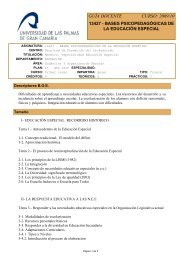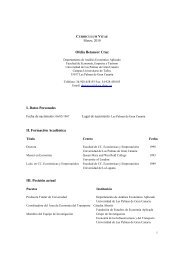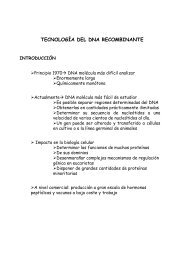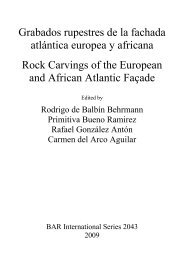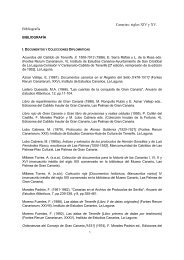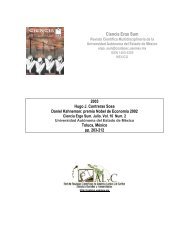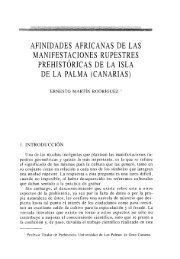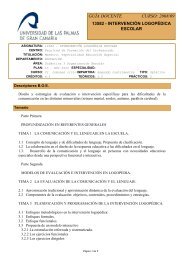Do emotions matter? Coherent preferences under anchoring and ...
Do emotions matter? Coherent preferences under anchoring and ...
Do emotions matter? Coherent preferences under anchoring and ...
You also want an ePaper? Increase the reach of your titles
YUMPU automatically turns print PDFs into web optimized ePapers that Google loves.
ECOLOGICAL ECONOMICS 66 (2008) 700– 711711Green, D., Jacowitz, K.E., Kahneman, D., McFadden, D., 1998.Referendum contingent valuation, <strong>anchoring</strong>, <strong>and</strong> willingnessto pay for public goods. Resource <strong>and</strong> Energy Economics 20 (2),85–116.Hanemann, W.M., 1984. Welfare evaluations in contingent valuationexperiments with discrete responses. American Journal ofAgricultural Economics 66, 332–341.Hanemann, W., 1985. Some issues in continuous <strong>and</strong> discreteresponse contingent valuation studies. Northeast Journal ofAgricultural Economics 14, 5–13.Hanemann, W.M., Loomis, J., Kanninen, B., 1991. Statisticalefficiency of double-bounded dichotomous choice contingentvaluation. American Journal of Agricultural Economics 73,1255–1263 (Nov).Harrison, G.W., List, J.A., 2004. Field Experiments. Journal ofEconomic Literature 42 (4), 1013–1059.Heberlein, T.A., Wilson, M.A., Bishop, R.C., Schaeffer, N.C., 2005.Rethinking the scope test as a criterion for validity incontingent valuation. Journal of Environmental Economics <strong>and</strong>Management 50 (1), 1–22.Herriges, J., Shogren, J., 1996. Starting point bias in dichotomouschoice valuation with follow-up questioning. Journal ofEnvironmental Economics <strong>and</strong> Management 30, 112–131.Heuer, F., Reisberg, D., 1990. Vivid memories of emotional events:The accuracy of remembered minutiae. Memory & Cognition18, 496–506.Hilgard, E.R., 1980. Consciousness in contemporary psychology.Annual Review of Psychology 31, 1–26.Hsee, C.K., Rottenstreich, 2004. Music, p<strong>and</strong>as <strong>and</strong> muggers: on theaffective psychology of value. Journal of ExperimentalPsychology. General 133 (1), 23–30.Idzikowski, C., Baddeley, A., 1983. Fear <strong>and</strong> dangerousenvironments. In: Hockey, Robert (Ed.), Stress <strong>and</strong> Fatigue inHuman Performance. Wiley, New York, pp. 123–144.Isen, A.M., Johnson, M.M.S., Mertz, E., Robinson, G.F., 1985. Theinfluence of positive affect on the unusualness of wordassociations. Journal of Personality <strong>and</strong> Social Psychology 48,1413–1426.Isen, A.M., Daubman, K.A., Gorgoglione, J.M., 1987. Theinfluence of positive affect on cognitive organization:implications for education. In: Snow, R.E., Farr, J.M. (Eds.),Aptitude, learning, <strong>and</strong> instruction. Erlbaum, Hillsdale, NJ,pp. 143–164.Kahneman, D., 1973. Attention <strong>and</strong> Effort. Prentice-Hall,Englewood Cliffs, NJ.Kahneman, D., Knetsch, J.L., 1992. Valuing public goods: thepurchase of moral satisfaction. Journal of EnvironmentalEconomics <strong>and</strong> Management 22 (1), 57–70.Kahneman, D., Frederick, S., 2002. Representativeness revisited:attribute substitution in intuitive judgment. In: Gilovich, T.,Griffin, D., Kahneman, D. (Eds.), Heuristics <strong>and</strong> Biases.Cambridge University Press, New York, pp. 49–81.Kahneman, D., Ritov, I., Schkade, D., 1999. Economic <strong>preferences</strong>or attitude expressions? an analysis of dollar responses topublic issues. Journal of Risk <strong>and</strong> Uncertainty 19, 220–242.Kahneman, D., Slovic, P., Tversky, A., 1982. Judgment <strong>under</strong>uncertainty: Heuristics <strong>and</strong> biases. Cambridge University Press,New York.Kahn, B., Isen, A.M., 1993. The influence of positive affect onvariety-seeking among safe, enjoyable products. Journal ofConsumer Research 20, 257–270.Kauffman, B.E., 1999. Emotional arousal as a source of boundedrationality. Journal of Economic Behavior <strong>and</strong> Organization 38,135–144.Langford, I., Bateman, I., Langford, H., 1996. A multilevel modellingapproach to triple-bounded dichotomous choice contingentvaluation. Environmental <strong>and</strong> Resource Economics 7 (3),197–211.Larsen, R.J., Diener, E., 1987. Affect intensity as an individualdifference characteristic: a review. Journal of Research inPersonality 21, 1–39.Lazarus, R., 1984. On the primacy of cognition. AmericanPsychologist 39, 124–129.Lazarus, R., 1991. Emotion <strong>and</strong> Adaptation. Oxford UniversityPress, Oxford.Leibenstein, M., 1987. Inside the Firm. Harvard University Press,Cambridge, MA.Lerner, J., Keltner, D., 2001. Feer, anger, <strong>and</strong> risk. Journal ofPersonality <strong>and</strong> Social Psychology 81, 146–159.Leventhal, H., Scherer, K., 1987. The relationship of emotion tocognition: a functional approach to a semantic controversy.Cognition <strong>and</strong> Emotion 1 (1), 3–28.Li, K., 1998. Bayesian inference in a simultaneous equation modelwith limited dependent variables. Journal of Econometrics 85,387–400.Loewenstein, G., 2000. Emotions in economic theory <strong>and</strong> economicbehaviour. American Economic Review: Papers <strong>and</strong>Proceedings 90, 426–432.McConnell, K.E., 1990. Models for referendum data. Journal ofEnvironmental Economics <strong>and</strong> Management 18, 19–34.McFadden, D., 1999. Rationality for economists. Journal of Risk <strong>and</strong>Uncertainty 19 (1/3), 73–105.McFadden, D., Leonard, G., 1993. Issues in the contingent valuationof environmental goods: methodologies for data collection <strong>and</strong>analysis. In: Hausman, J. (Ed.), Contingent Valuation: A criticalAssessment. North Holl<strong>and</strong>, Amsterdam, pp. 165–208.Oatley, K., 1992. Best Laid Schemes: The Psychology of Emotions.Cambridge University Press, New York.Poe, G.L., Clark, J.E., Rondeau, D., Schulze, W.D., 2002. Provisionpoint mechanisms <strong>and</strong> field validity tests of contingentvaluation. Environmental <strong>and</strong> Resource Economics 23,105–131.Rondeau, D., Schulze, W.D., Poe, G.L., 1999. Voluntary revelation ofthe dem<strong>and</strong> for public goods using a provision pointmechanism. Journal of Public Economics 72, 455–470.Scarpa, R., Bateman, I., 2000. Efficiency gains afforded by improvedbid design versus follow-up valuation questions in discretechoice CV studies. L<strong>and</strong> Economics 76, 299–311.Sen, A., 1982. Choice, Welfare, <strong>and</strong> Measurement. HarvardUniversity Press, Cambridge.Sloman, S.A., 1996. The empirical case for two systems ofreasoning. Psychological Bulletin 119, 3–22.Slovic, P. (2000). The Construction of Preference in Kahneman, D.,<strong>and</strong> Tversky, A. (Eds.), Choices, Values <strong>and</strong> Frames. New York:Cambridge University Press <strong>and</strong> the Russell Sage Foundation.Slovic, P., Finucane, M., Peters, E., MacGregor, D.G., 2002. The affectheuristic. In: Gilovich, T., Griffin, D., Kahneman, D. (Eds.),Heuristics <strong>and</strong> biases: The psychology of intuitive judgment.CambridgeUniversity Press, New York, pp. 397–420.Smith, A. (1759). The Theory of Moral Sentiments. London, A.Millar, Edinburgh, A. Kincaid & J. Bell.Tversky, A., Kahneman, D., 1986. Rational choice <strong>and</strong> the framingof decisions. Journal of Business 59.Tversky, A., Kahneman, D., 1974. Judgment <strong>under</strong> uncertainty:Heuristics <strong>and</strong> biases. Science 185, 1124–1131.Whitehead, 2002. Incentive incompatibility <strong>and</strong> starting pointbias. L<strong>and</strong> Economics 78 (2), 285–297.Yates, J.F., 1990. Judgement <strong>and</strong> Decision Making. Prentice-Hall,Englewood Cliffs, NJ.Yerkes, R.M., <strong>Do</strong>dson, J.D., 1908. The relation of strength ofstimulus to rapidity of habit-formation. Journal of ComparativeNeurology <strong>and</strong> Psychology 18, 459–482.Zajonc, R.B., 1980. Feeling <strong>and</strong> thinking: <strong>preferences</strong> need noinferences. American Psychologist 35, 151–175.Zellner, A., 1971. Introduction to Bayesian Inference inEconometrics. Wiley, New York.



